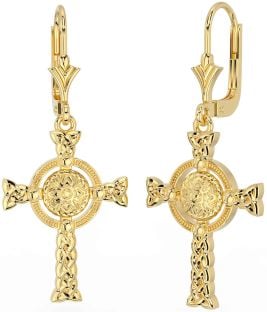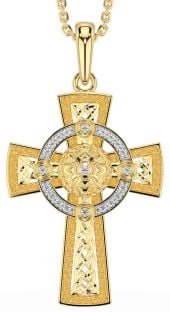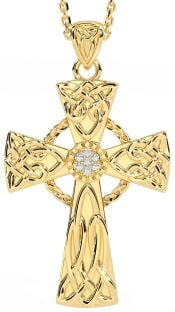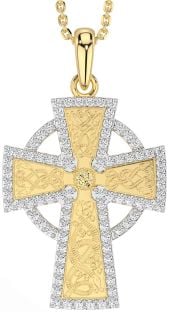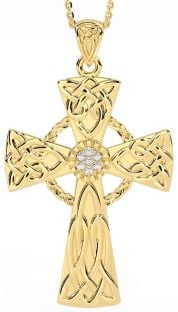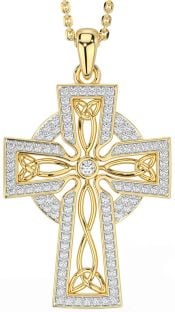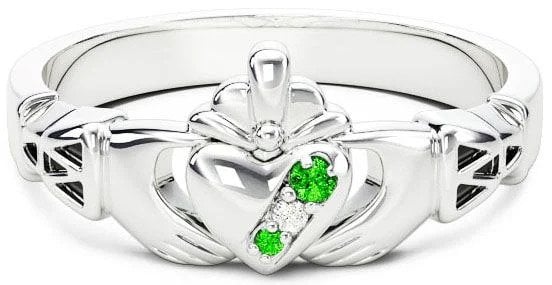Diamond Gold Silver Celtic Warrior Cross Necklace
Free Shipping
Get it in USA by Tuesday, Jun. 24 >
This Celtic Warrior Cross Necklace [Selection_stone] The current selection is made from . Set with . . . . [general] [Cross_short] [Warrior_short] [Celtic_short]
Item Details
This Celtic Warrior Cross Necklace comes in Gold and Silver set with a choice of Diamonds and Gemstones. The current selection is made from . Set with . . . .
Individually handcrafted in Ireland. Guaranteed Quality.
Throughout Ireland & Scotland, the celts crafted these magnificent symbols in stone. Celtic Crosses pre-date Christianity and were first used by pagans to worship the sun. The Celtic Cross is now a symbol associated with Ireland and Christianity.
The design is inspired by one of the finest known works of Celtic art, thought to have been owned by a high status Celtic Warrior King, the "Ardagh Chalice" made in the 9th century AD.
Celtic Designs have been around since ancient times and have long been applied to create fine art. Their distinctive patterns have appeared on stone, metalwork, in jewellery and on magnificent illuminated manuscripts. This beautifully crafted piece is a fine example of the exquisite work of the celts handed down from generation to generation.
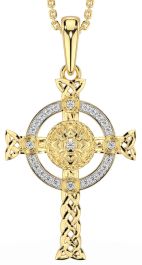
See Full Details
STONE
| Type |
N/A |
| Quality Grade |
N/A |
| Size |
1.3 mm |
| Weight |
N/A |
SETTING
| Height (excl bail) |
26 mm |
| Width |
19 mm |
| Metal |
|
ENGRAVING
|
Your special message... |
Chain
|
N/A |
Meaning of Design
Celtic Crosses: Throughout Ireland & Scotland, the celts crafted these magnificent symbols in stone. Celtic Crosses pre-date Christianity and were first used by pagans to worship the sun. In pagan times the circle of the Celtic cross represented the sun, being the center of their lives. It was not until the 4th century AD when it was introduced by the first Christian Roman Emperor Constantine, that the Celtic Cross was used to represent Christ's victory. During the great conversion of many pagans to Christianity, Christian Philosophers adapted the Celtic Cross and thought the meaning of the circle to represent Christ, the center of Christianity.
The Celtic Warrior: design is inspired by one of the finest known works of Celtic art, thought to have been owned by a high status Celtic Warrior King, the "Ardagh Chalice" made in the 9th century AD. Celtic Warriors were known to have been the most fierce in the ancient world, conquering Rome in 390 BC under the command of the Celtic Warrior King Brennus. An tale of the Celts comes from an account about an embassy of Celts from the Adriatic that caught up with Alexander the Great in 335 B.C. Apparently, the great man was impressed by their fearlessness, and he asked if there was anything the Celts truly feared. They replied, "Only that the sky should fall on our heads." The Ardagh Chalice is a two-handled silver cup, decorated with silver, gold, and enamel, assembled from 354 separate pieces. The names of the apostles are incised in a frieze around the bowl, below a girdle bearing inset gold wirework panels of animals, birds, and Celtic designs. Techniques used include hammering, engraving, Lost-wax casting, filigree applique, cloisonne and enamelling. It was found in 1868, together with four brooches, by two young boys, digging in a potato field on the south-western side of an ancient Celtic fortified dwelling know as a "rath" (ring fort), in County Limerick, Ireland. It had a golden cup within it, and four ornate brooches. Buried without the least protection as they were, the pieces must have been interred in a hurry, probably temporarily, as the warrior intended to return for them at a later time after a battle.
Celtic Designs: have been around since ancient times, created by the highly artistic Celtic peoples, Celtic designs have long been applied to create fine art. Their distinctive patterns have appeared on stone, metalwork, in jewellery and on magnificent illuminated manuscripts. This beautifully crafted piece is a fine example of the exquisite work of the celts handed down from generation to generation.

Customer Reviews
Verified Customer Reviews
from this merchant give
them a 4 or 5-Star rating.
How to Find Your Ring Size
Sizing Tips
Finding your ring size is very simple. For the most accuracy, measure the inside diameter of an existing ring (worn on the same hand and finger), and then find that measurement on the Ring Sizing Chart. If you don’t have a ring to use, follow these easy steps:
Step 1: Cut a strip of paper long enough to fit around your finger
Step 2: Wrap the paper around your finger, just above the knuckle, and mark the point at which the two ends meet
Step 3: Measure the paper from mark to mark
Step 4: Find that measurement on the Ring Sizing Chart to locate your size
Free Resizing
If you still don't know the exact ring size to order, rest assured, we provide one (1) FREE resizing of your ring within 60 days of the original shipping date. This includes items that have been engraved.
Relationships
Grá: Means ‘love‘ (pronounced ‘graw’) copy
Cara: Means ‘friend‘ (pronounced 'Kaw-rah') copy
Croí: Means ‘heart‘ (prounounced 'cree') copy
Peata: Means ‘pet‘ (prounounced 'fat-a') copy
Stór: Means ‘Treasure‘ (pronounced ‘store’) copy
Meala: Means ‘Honey‘ (Prounounced 'M-alla') copy
Clann: Means ‘Children‘ (Prounounced 'Klan') copy
Iníon: Means ‘Daughter‘ (Prounounced 'in-yeen') copy
Mac: Means ‘Son‘ (Prounounced 'Mack') copy
Agra: Means ‘Love, Beloved or Sweetheart‘ (Prounounced 'Ag-rah') copy
Síor: Means ‘Always‘ (Prounounce 'Sheer') copy
Religious
Dia: Means ‘God‘ (Prounounced 'Dee-a) copy
Naofa: Means ‘Holy‘ copy
Anam: Means ‘Soul/Spirit‘ copy
Naomh: Means ‘Saint‘ copy
Diaga: Means ‘Divine‘ copy







